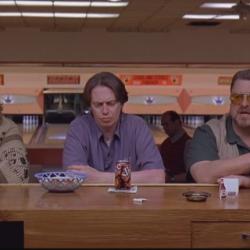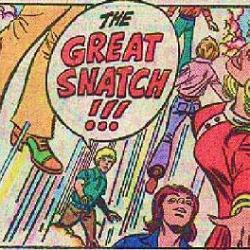Originally posted February 6, 2009.
You can read this entire series, for free, via the convenient Left Behind Index. The ebook collection The Anti-Christ Handbook: Volume 1, is available on Amazon for just $2.99. Find a location and hit the streets to save democracy. Volume 2 of The Anti-Christ Handbook, completing all the posts on the first Left Behind book, is also now available. Volume 3 is coming soon.
Left Behind: The Movie [2000] has conveniently been divided into 11 parts for posting on YouTube. This neatly provides us with stopping points as well as the ability to watch together as we work our way through the movie. Today we look at part 11 of 11. [Note: That 11-part bootleg is no longer on YouTube, but the entire 2000 movie is here. You can still watch along if you’re masochistic enough to want to do so.]
There’s a felicitous meeting of art and artist in this scene as both Gordon Currie and Nicolae Carpathia finally stop struggling against destiny and give in to their role in this abysmal plot.
Currie does his best here to use what he’s been given. He takes the arbitrary silliness of the action and mines it for a sense of unpredictability that adds a nice touch of menace. You’re not quite sure if he’s going to shoot somebody or start singing.
The plot here is intended to show Nicolae as cool and calculating, but the deeds he performs here in the Big Finale — mostly faithful to the same scene in the book — don’t seem like the actions of a mastermind. This is, again, meant to be his grand display of power, but it happens in a closed room witnessed only by his inner circle. He wants these lieutenants to be impressed by his awesome mind-control mojo, but at the same time he’s employing that mojo to make them forget what they’re seeing. He stages a fake suicide, but does so in such a way that his fingerprints, but not the victim’s, are on the gun.
Currie makes a good choice here, then, to portray Nicolae as less mastermind and more out-of-his-mind. That choice works. (It works better, at least, than does Currie’s habit of mistaking louder for more forceful. If he’d gotten to work with Pilon for more than his quickie punch-the-clock appearance here as Stonagal, I think the old pro might’ve helped to correct that misapprehension.)
Nicolae circles the table one more time, stopping by Buck to deliver a nice little barbed speech. This bit varies from the novel, and it would have been an elegant innovation if there’d been any follow up to it at all:
I know that you wanted to do that for Dirk and Allen. But I could not have my new media liaison with blood on his hands. I have big plans for you, Buck. That story you sent to GNN about Stonagal and Cothran should be airing right at this very moment. The whole world will feel sympathy and love for me. They will follow me wherever I lead them, because of you. So thank you, Buck.
There’s a good bit there that might have been fun if Buck had been played by anyone other than CamCam. But he just sits there through the whole whispered speech with the same uncomfortably puzzled look he’s had in every scene up until now. One realizes as Nicolae says it that Buck ought to have been angry about the murder of his friends, but that he hasn’t displayed any trace of such anger, or even of sadness, over their deaths.
In the book, Buck agreed to bury the Stonagal story in exchange for a promise of personal safety. Here though, CamCam has actually done what book-Buck never bothered or dared to do — he wrote a story exposing Stonagal’s conspiracy. And that noble deed, Nicolae tells him, was all part of the plan. Without Buck’s actions, the Antichrist could never have risen to power.
Watch that scene again. Watch CamCam’s reaction.
See if you can spot one. I couldn’t. CamCam isn’t talking, so CamCam isn’t acting.
And that’s a shame, since apart from CamCam’s flaccid presence, this scene is one of the rare few in this movie that almost works. When they stick to showing us Currie and Colin Fox, the “terribly sad” bit rises to the level of a passable Grade B SyFy original.
Fox has his own actor/character confluence in the following scene in the hallway. Everyone else has been brainwashed into believing they witnessed Stonagal shoot Cothran and then himself and only CamCam — protected by the divine anti-Antichrist mojo of Chloe and Rayford’s magical prayers — remembers what really happened. He approaches a dazed and perplexed looking Chaim Rosenzweig.
BUCK: Chaim! Chaim! What did you see?
FOX: What … what am I doing here? I’ve been in more than a hundred movies. I don’t need …
BUCK: Chaim, Nicolae! What about Nicolae?
FOX: The poor man, he was so deceived. But … but he needed the money. I offered to get him some work on Psi Factor, but he … [wanders off, shaking his head sadly]
This is followed by a two-shot conversation between CamCam and Mrs. CamCam in which the director, inexplicably, lingers on their respective reaction shots. He blinks three times. She blinks once. It’s like watching the championship round of Make Me Laugh.
CamCam winds his way down a marble staircase — the perfect acoustic setting for multiple news crews broadcasting from the lobby. “In a world sadly lacking in leadership,” one of them intones, “Carpathia stands oat.” But CamCam doesn’t stick around. He’s leaving Toronto for good.
“Everything the Bible predicted is happening,” CamCam says in an awkwardly breathless voiceover as we see him arriving safely back in Wheaton. “If this is true, and the Antichrist is coming to power, then this is just the beginning …”
He says this as though he were no more involved in any of this than we viewers are. There’s no sense that he was listening to what Nicolae just told him. At this point, CamCam should instead be thinking: “All the horrible things the Bible predicted are happening. … The Antichrist is coming to power and it’s all my fault.”

But instead his next line neatly captures the prurient nastiness at the heart of the movie, the book, the whole series: “The next seven years are going to be the worst that mankind has ever seen.”
That’s not a conclusion to the story this movie has been telling. It’s an advertisement for the sequels. The audience is expected to hear this with the same eager enthusiasm and excitement CamCam has: “The next seven years are going to be the worst that mankind has ever seen” — how cool is that? War and famine, death and Hades — this is gonna be awesome!
This is what CamCam and the screenwriters think of as a happy ending: “And all those other people died eternally in agony. The End.” But it’s not just their idea of a happy ending to this movie. It’s their idea of a happy ending for all of human history. This is what they believe will happen. This is what they want to happen. “The worst that mankind has ever seen” is what they’re fervently praying for.
CamCam strides up to the door of the New Hope Village Church, grinning. “The next seven years are going to be the worst that mankind has ever seen,” he thinks, and the thought makes him smile.
Chloe, opens the door, sees CamCam and smiles. She’s smiling because she was worried about him and she’s happy he isn’t dead. So they’re both smiling, but for different reasons. I give this relationship six months — seven years at most.
The one thing to like about this final scene (other than that it’s the final scene) is that it avoids the cinematic, but unfilmable, final scene in the novel. Jerry Jenkins had the Steeles and Bruce meeting Buck at the airport and finished his book this way:
They moved through the terminal toward the parking garage, striding four abreast, arms around each other’s shoulders, knit with a common purpose. Rayford Steele, Chloe Steele, Buck Williams and Bruce Barnes faced the gravest dangers anyone could face, and they knew their mission.
It might have been fun to see this played out as the last shot of the movie, just as Jenkins imagined it, just to witness the awkwardness of what it would mean for this group to stride “four abreast, arms around each other’s shoulders” through a crowded airport terminal. But unlike the hack novelist dictating his ending from the Bad TV Show in his head, the filmmakers would have had to worry about actually getting four actors to perform this Yellow Brick Road stroll through O’Hare, so they had to change it.
Dozens of such necessary changes are why the movie, as bad as it is, isn’t able to achieve quite the same level of extravagant awfulness that the book achieves. Thus my general thesis on Left Behind: The Movie, which is that this is a Very Bad film. It is sloppy, careless and unforgivably dull.
But it’s better than the book.
This is often true of such adaptations. Very Bad movies tend to be a bit more bearable than Very Bad books. If nothing else, they’re shorter. Plus, the medium forces an economy of storytelling — a reliance on showing rather than telling — that benefits this adaptation, even though what is being shown still doesn’t make sense and even though director Vic Sarin and his star, CamCam, seem to be almost wholly incapable of showing us what they need to show us here.
But it’s not enough only to say that the book is worse. The book is epically, transcendently bad. And that may, in an odd way, make the book more worthwhile than the movie, because for all of its awfulness, there’s nothing really epic or transcendent about it.
What I’m getting at is that LBTM fails to be quite as instructively bad as the novel it’s based on. This Very Bad movie — and the unqualified praise of its fans — has something to teach us about the warped standards of subcultural popular entertainment. It’s yet another example of what Daniel Radosh describes as “seeing devout Christians embrace something … sacrilegious.” But it’s sacrilege is never as horrifying or quite as unintentionally hilarious as the relentless blasphemy of the book. Nor is it as illustrative.
Sturgeon’s Law usefully states that “95 percent of everything is crap.” Most of that 95 percent is utterly disposable and forgettable, yet some of it rises so far above — or falls so far below — the rest of the crap that it achieves its own kind of perverse immortality. This sometimes happens with Very Bad movies that achieve cult status — movies we tend to describe as “so bad they’re good.” What we mean by that, I think, is that these movies are entertainingly bad. They are delightfully bad — awful in audacious ways that can prompt a response of shocked (schlocked) delight.
LBTM is bad, but it’s neither entertaining nor delightful. You can see this if you think about the idea of a LBTM drinking game. The notion sounds amusing at first, but the prospect of having to actually sit down and watch this movie takes all the fun out of it.* Unlike, say, Red Dawn or anything by Ed Wood, this movie is itself too much of a buzzkill. For all of its faithfulness to the howlingly strange plot of the novel, the overall impression one comes away from this movie with is of a bland dullness. That is, in itself, an astonishing realization about a film that relates events of the such devastating enormity, but there it is. In the final analysis, this movie is simply far more boring than it has any right to be.
If you turn back to the classic movies in this genre you’ll find that they may be many things — appalling, amateurish, preachy, naive, poorly constructed — but they’re not boring.
The true classics of this genre — Very Bad PMD apocalyptic thrillers — are Donald W. Thompson’s trilogy A Thief in the Night, A Distant Thunder and Image of the Beast. Like Tim LaHaye, Thompson had studied his Hal Lindsay, but he’d also studied his George Romero. Night of the Living Dead showed Thompson how to portray a global apocalypse with a microscopic budget. Thompson wasn’t a tenth of the artist Romero is, but his scare-them-into-heaven Christsploitation** flicks, with their casts of amateurs, seem far more compelling and entertaining than the bigger-budget LBTM. See for example the infamous Lawnmower Scene, Thompson’s big Rapture shot. (And yes — O frabjous day — the whole movie can be viewed on YouTube. Start here.)
Thompson didn’t make good movies, but he seems to have made the best movies he could. Unlike Vic Sarin, he cared enough to try.
I may just be viewing A Thief in the Night with the fondness of nostalgia, but I think it’s charming in a way that LBTM cannot be because it’s earnestly didactic, where LBTM is smugly didactic. Thief is relentlessly preachy, but you sense that these are people who really believe they’re trying to save you from hellfire and damnation. LBTM is preachy too, but the point of its sermonizing is that you deserve hellfire and damnation and the joke’ll be on you when you’re in the Lake of Fire looking up at them in heaven realizing how right they were and how wrong you were and how much smarter than you they turned out to be after all and how now I bet you wish you hadn’t laughed at them on the school bus that one time in front of that pretty girl.
And but so, I can’t recommend LBTM as “so bad it’s good.” I just can’t see this achieving, or deserving, cult-movie status.
It is a cult-movie, of course, just not in that way. If you’re interested in learning more about that particular cult — the “prophecy”-obsessed PMD wing of American evangelicalism — you’re probably better off slogging your way through the god-awful book than through this god-awful movie.
The book shows us how these folks think and what their fantasies are like — what it is they want America to become.
The movie merely shows us what they want Hollywood to become. Still frightening, but not quite as important.
– – – – – – – – – – – –
* Creating such a game in comments, however, may be more entertaining. Some starting suggestions: CamCam gives a vacant stare: Take a sip. Someone says “tracts of land”: Chug.
** Credit to G. Noel Gross for identifying these movies as just that: Evangelical exploitation films. And not just because of the sideburns. Plus Gross provides this fine summary of A Thief in the Night:
Notables: No breasts. Two corpses. Flirtatious winking. Gratuitous Humphrey Bogart impression. Bug squashing. Happy marriage montage. Puppetry. Foot chase. Helicopter harassment.












